UNDER THE SKIN: HONDA CIVIC TCR
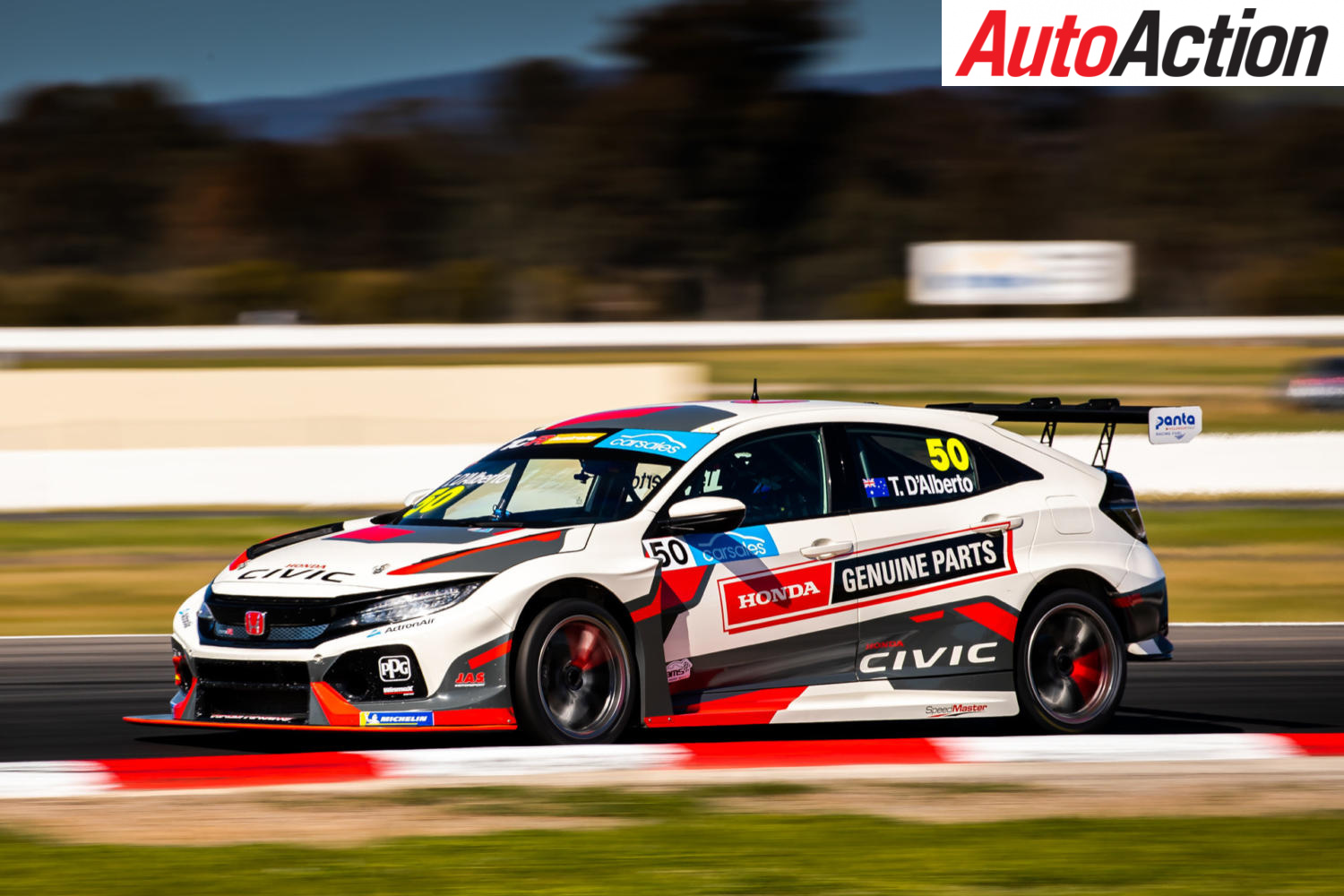
Honda was one of the first brands represented on the TCR grid, but it was through the team’s long-time collaborator, Italian-based team JAS Motorsport. The latest generation of the Civic Type R TCR has been a race winner across the world and Heath McAlpine discovers how.

Under The Skin – Honda Civic TCR
Images: InSyde Media/TCR Australia/Daniel Kalisz
The growth of TCR can be demonstrated through the development of the various models that participate in the series and the Honda is proof of how far the class has advanced since its infancy in 2014.
JAS Motorsport are well versed in developing a Honda touring car having a large history of being the Japanese manufacturer’s go to team when developing its next weapon. The Italian team began preparing and developing the Accord Super Tourer in the late-1990s contesting the ADAC STW in Germany, the British Touring Car Championship and European Super Touring Championship on behalf of Honda.
Following on from that, it was a privateer team in the reborn World Touring Car Championship in 2005 with an S2000-spec Accord Euro R experiencing moderate success despite running on a shoestring.
But the latest model to be developed by JAS is the hugely popular Honda Civic Type R, an already aggressive-styled model to start off with, but given the TCR treatment it further emphasises the point. It is the Italian team’s second generation TCR model after the first was based on the previous FK2 Civic, kicking off the next successful collaboration between JAS and Honda.
With the arrival of the FK8 Civic Type R in 2017 came an updated TCR variant from JAS, which has now hit Australian shores this year with the introduction of TCR Australia and the support of Wall Racing, headed by Porsche Carrera Cup Australia winner David Wall.
Honda Australia announced it was supporting the program with moderate support as a toe-in-water exercise through driver Tony D’Alberto, who was partnered by former international open-wheel ace John Martin. Having originally began the season with two-cars, it expanded to three at Queensland Raceway as Kiwi driver Jordan Michels debuted in the series before Tim Brook and factory Honda WTCR driver Nestor Girolami shared the drive at the next two drives.
Girolami dominated his guest drive at Sandown, D’Alberto took one pole position on his way to second in the title and Martin was plagued by bad luck, but did take victory at The Bend Motorsport Park in June.
Amazingly, many of the components are shared between the road-going and TCR-specification Honda Civic Type R starting with the heart, the Japanese manufacturer’s world famous VTEC inline four-cylinder engine.
This is lightly modified to cope with the stresses of racing as Wall explained to Auto Action, it is basically identical to the road-going unit.
“It’s a road car engine that has a head gasket changed,” Wall told Auto Action. “Honda is obviously more than confident with its product.”
The transversally installed K20C1 VTEC engine is turbocharged, features two overhead camshafts and 16 valves, which delivers a maximum power of 253kw (340hp) and 420Nm of torque. The engine is sealed at JAS Motorsport’s Milan factory, with Wall Racing allowed only to complete basic servicing of the engine in its workshop.
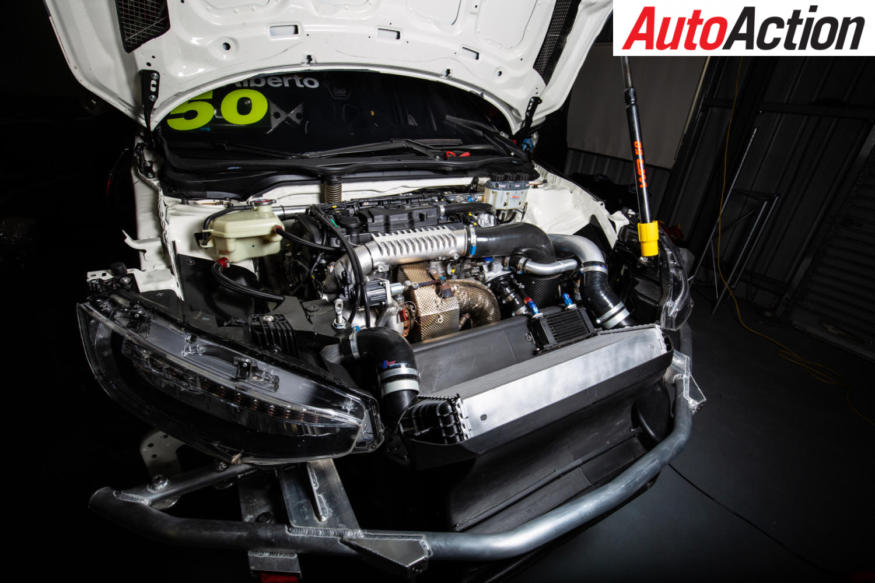
A wet sump provides the lubrication and cooling is provided by two intercoolers installed in a v-mount configuration at the front of the Type R TCR. To ease accessibility, the whole front section of the car is one piece allowing the Wall Racing crew to take the intercooler, heat exchanger, brake ducting and the aluminium extrusion bar as one piece.
MoTeC provides the Civic Type R TCRs brain in the form of its advanced M142 ECU, which has the ability to be installed in a road car, again demonstrating how close TCR-specification models are to the road-going variants.
Mated to the VTEC engine is a six-speed sequential SADEV gearbox with paddleshift sending power through a twin-disc sinter-metallic clutch to the driveshafts and mechanical slip diff, all items manufactured by JAS Motorsport.
“It runs a Sadev dogbox, which is a very good box and is quite user friendly for the boys to work on, it has good adjustability as far as the diff side of things, which is an important part of these cars,” Wall said. “The halfshafts or the driveshafts are manufactured for these cars by JAS.”
Wall although further elaborated on the function of the paddleshift.
“There is a sequential pneumatic air-shifter fired by a trigger by the driver, paddleshift that has a compressor that runs the actuator that fires the gear into the box,” Wall described.
Suspension-wise, the TCR-specification Honda Civic Type R TCR is completely distanced from its street counterpart where it runs gas-filled Ohlins TTX shock absorbers all round partnered with a homologated range of springs, while the package is completed by an adjustable three position anti-roll bar at the front.

A multilink axle at the rear combined with the homologated spring range and an anti-roll bar positional to three settings, just like up front. JAS manufacturers all the uprights and arms in-house providing a sweet handling package with a distinct window it operates well in.
“Like any race car, it has its sweet spot depending on where you are,” said Wall. “We have homologated springs that we’re allowed to work within and those springs vary from event to event.”
Steering is an electric power assisted rack and pinion system.
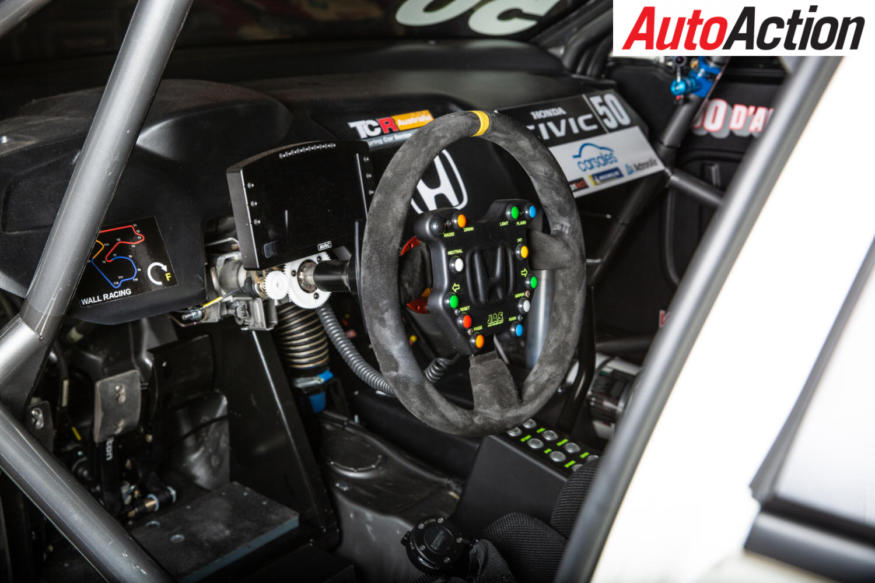
A JAS-branded brake package comprises of a 380mm steel ventilated disc at the front mated with a six-piston monolithic caliper at the front, while the rear features a two-piston monolithic caliper and 258mm steel discs. Inside the Type R TCR, there is remote brake bias and AP brake pressure limiter controlled by the driver, while a ‘rally-style’ handbrake complements the package.
A specially-designed OZ 18”x 10” rims for the Civic Type R TCR, which are wrapped in the Michelin S9 hard compound tyres, which took Wall Racing a bit to get familiar with due to the various tyre brands that TCR categories worldwide run under.
“The Michelin S9 has proven to be very good, very different at the start of the season because these cars run on other tyre manufacturers across the world so there was an exercise there to make those work,” Wall disclosed.
A standard five-door Honda Civic FK8 Type R is used as the basis of the race car, but then has an MSA-certified TIG-welded, chrome-moly roll cage installed and a custom designed composite body kit consisting of front bar, rear bar, wing and a portion of the rear door, which is grafted to the original item. The big rear wing adds further downforce with the aerodynamic features also extend to small diffuser at the rear. Wall also further explained the manufacturer of the other components of the Civic Type R TCR, that lowers the weight and improves engine performance.

“The rear decklid and bonnet are a manufactured from the standard items, then fabricated to suit the outcome of what the car needs,” Wall said.
Inside, MoTeC instruments greet the driver with a PDM30 power box partnered by a C127 instrument panel, tunnel mounted switch panel and a suede covered quick release steering wheel, which features further instrumentation including the radio, headlights and indicators.

An adjustable Tilton pedal box rests at the feat of the driver, while the seating position has been slightly moved to the centre of the interior to aid with weight distribution as Wall explained.
“It’s very user friendly,” Wall said of the interior. “Adjustable pedal box, collapsible steering column – up-down, in-and-out – then the seating position is a little in board, but has movement forward and backwards your runners as such are gone, so it’s a bolted in homologated bracket and seat.”
The seat is provided by OMP and is combined with a six-point safety harness, while safety items include an automatic fire extinguisher system and behind the driver where the rear seats are normally located, a 100-litre FTR fuel tank featuring a bladder sits.
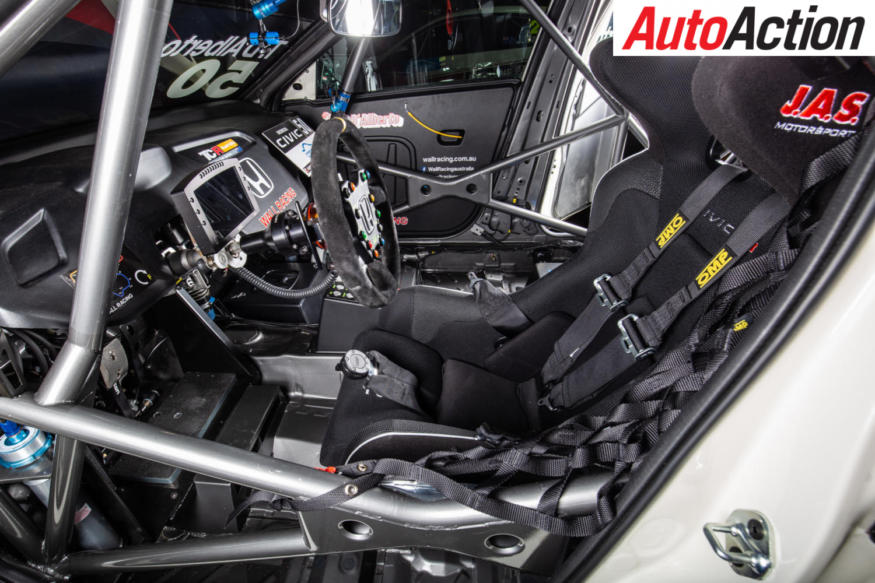
Balance of Performance for the Honda remains 100% engine performance, 20kg ballast and ride height is at 80mm.
JAS Motorsport’s support of the continually growing TCR Australia Series has been incredibly enthusiastic with technicians aiding Wall Racing at most rounds this in the New South Wales-based team’s role as JAS Motorsport agents for Australia and New Zealand.
This means Wall Racing is the one-stop shop when it comes to technical support, spare parts and anything related to the Honda brand racing in Australia with the relationship continuing to grow after being announced just over a year ago.
“We manage all those things on its behalf if you like as well as running some cars on top of that,” Wall explained.
“The relationship is very good with JAS, we basically talk to them through our technical alliance as JAS also run cars overseas constantly in most countries, so we get live information from those guys if there are any questions or problems that may arise during a weekend.
“Between race weekends, they’re more than ready to help us in anything we need to do to fix anything from our end down here.
“JAS want to see everything go well out here as much as we want it to, so it’s in its best interests to be able to help out with some technicians and help during race weekends to fast track our side of it, then to once again we’re getting 100% from the package we’ve got and most times the technicians have come out we’ve been able to do that.
“Moving forward, it’s a good relationship and it’s still continuing to grow, we feel like we’ll have more support from JAS Motorsport’s side of things, more than likely having those technicians come out and help will be a regular occurrence.”
This is the fourth version of a TCR variant Auto Action has featured in its Under The Skin feature series and the Honda is very similar to the factory developed Audi and Hyundai compared to the privately backed Romeo Ferraris Alfa Romeo Giulietta Veloce TCR. The Honda sits in the middle as a factory backed project built by an outside source.
It highlights how competitive and equal the TCR category is as all four of the above visited the winners circle in Australia this year, though with a year’s Honda experience under the belt, Wall Racing will be eager to go one step better in 2020.
A SURPRISE PACKET
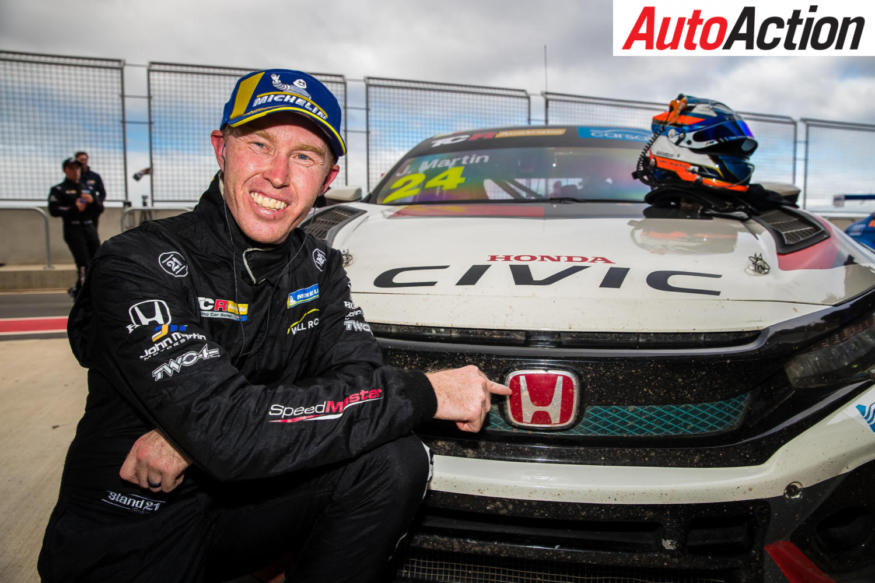
More used to high-powered open-wheelers and aero-dependant GT sports cars, John Martin was pleasantly impressed by the Honda upon his first outing.
“Right from the very test day, I was actually surprised,” Martin enthused. “I thought it wouldn’t be that good, but I was surprised by how good they are, it has so much grip and I think that’s what makes the racing so great obviously they don’t have too much aero.”
Despite being a vastly experienced driver, Martin was thrown in the deep end adapting to front-wheel-drive and found that setting up the Civic Type R is completely different to what he was used to, voicing some doubts about the directions made.
“It was totally new to me as it was for most people in the category, I look back at the seven rounds and I’ve learnt so much about how a front-wheel-drive touring car works,” Martin implored.
“It took a while to get my head around it and I reckon I’m still getting my head around it, little things like how you drive them, how you set them up as well, how you explain stuff to an engineer with what the car is doing and changes you might want to make.”
Driving a TCR race car is a punishing affair, one minor slip up or exceeding the limit by a minuscule amount can have dire consequences.
“You just have to drive them really loose on the way in to get the mid-corner rotation, well you do in the Honda anyway,” Martin told Auto Action.
“I hate entry oversteer, so I’ve had to live with that, but I reckon going forward driving one has definitely helped me as a driver in every other aspect. I don’t mind backing the thing in, it’s just a fine line of just how much you have with how much grip when you get off the brake, there’s always a very fine line.
“They’re cool little things, they’re challenging. Certainly, during a race I had the front tyres going away you want to throw the rear around a bit more, but you can back it in to a certain extent, but anything more than 5-10% it just snaps straight away then you sail straight off. It’s very difficult and very easy to make a mistake when it’s like that too.”
It goes with setting up the Civic Type R TCR as well making communication extremely important between driver and engineer. Luckily, team boss David Wall is able to be the middleman to help translate what the driver wants and how the engineers find a solution.
“I wouldn’t say easy, there are a lot of things I’d suggest like a spring or bar or something like this and I’ve gone back to if it was a normal car I’d like this,” Martin said. “It’s good to have Wallee there to because he understands what that feeling is and what I want for it. He has a fair idea, then the engineers translate that into front-wheel-drive language.
“As we go on further and further, I can say, ‘I think it needs this, I think it needs that’, because we’ve tried it already whereas at the start we hadn’t done anything and I suggested somethings that thought ‘there’s no way I’m going to make it out of pit lane, I’ll spin leaving the box, no way it’s going to work’ then to my surprise I’m eating humble pie.
“You go out and actually that was pretty good.”
TECH SPECS – HONDA CIVIC TYPE R TCR
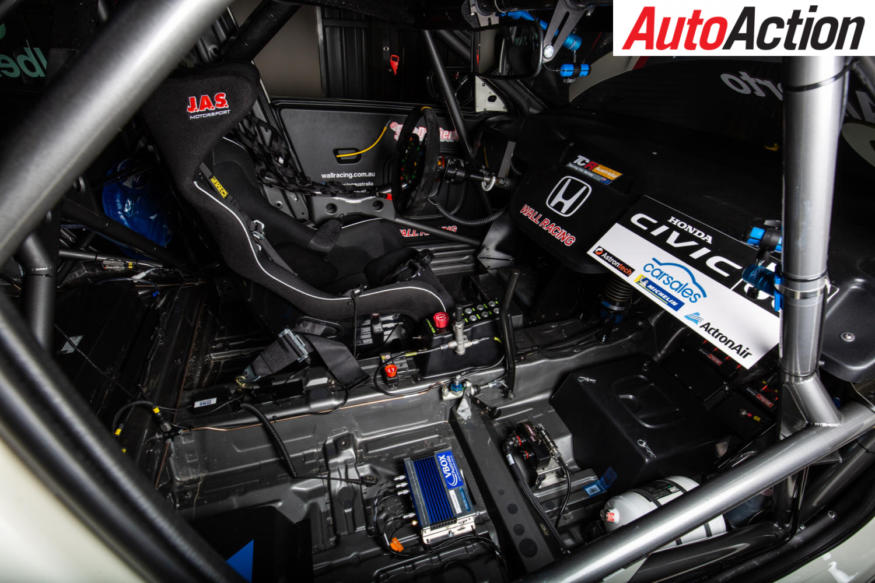
BODY – Composite wide body for Honda Civic FK7 Hatchback, 5 doors
ENGINE
CYLINDERS/CAPACITY – 4 cyl/2000 cc turbocharged
DISPLACEMENT – 1998.2 cc
BORE x STROKE – 86 x 86 mm
MAXIMUM OUTPUT – 340hp @ 6200 rpm
MAXIMUM TORQUE – 420nm @ 3800 rpm
LUBRICATION – wet sump
COOLING – Plastic duct for engine water radiator and intercooler
ECU – MoTeC M142
EXHAUST – 3-inch stainless steel 310 – silenced OPTION available
TRANSMISSION
Front-wheel-drive
GEARBOX – 6-speed sequential – SADEV with Paddle shift
GEARBOX OPTION – 6-speed sequential – XTRAC with Paddle shift
CLUTCH – multi-disc sinter-metallic
DRIVELINE – Tripod-CV joint heavy duty
DIFFERENTIAL – mechanical limited slip differential
ELECTRONICS
DISPLAY/LGGER – MoTeC C127
POWER BOX – MoTeC PDM30
SUSPENSION
FRONT – McPherson strut, coil springs, adjustable anti-roll bar 3 positions
REAR – Multilink, coil springs, adjustable anti-roll bar 3 positions
SHOCK ABSORBERS
FRONT – Gas-filled Ohlins TTX McPherson
REAR – Gas-filled Ohlins S46 eye-eye – TTX36 ILX (OPTION)
BRAKES
Dual circuit hydraulic system
FRONT – 6 pistons monolitic calipers – 380 mm steel ventilated discs
REAR – 2 pistons monolitic calipers – 258mm steel discs
PEDALBOX – Floor mount with remote Bias and limiter
STEERING – Electrical power assisted rack and pinion
WHEELS AND TYRES – 18x10inch O.Z. Racing
INTERIOR
OMP composite HTE seat, Automatic extinguisher
ROLLCAGE – MSA certified Welded cage with lifting devices
DIMENSIONS
WEIGHT – 1265 kg
WIDTH – 1950 mm
LENGTH – 4549 mm
WHEELBASE – 2700 mm
BALANCE OF PERFORMANCE
ENGINE PERFORMANCE LEVELS: 100%
BALLAST: +20kg
RIDE HEIGHT: 80mm


